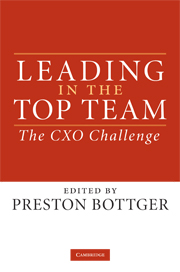Book contents
- Frontmatter
- Contents
- Figures
- Tables
- Contributors
- Editor's Acknowledgments
- 1 Introduction – Leading within and across the functions
- Section I The Business Imperatives
- Section II The CXOs: Within the Functions
- Section III The CEO and the Leadership Team – Pulling it all together
- Conclusion
- Index
- References
1 - Introduction – Leading within and across the functions
Published online by Cambridge University Press: 19 August 2009
- Frontmatter
- Contents
- Figures
- Tables
- Contributors
- Editor's Acknowledgments
- 1 Introduction – Leading within and across the functions
- Section I The Business Imperatives
- Section II The CXOs: Within the Functions
- Section III The CEO and the Leadership Team – Pulling it all together
- Conclusion
- Index
- References
Summary
Leadership is the job of every member of the senior management team … The CEO is simply the leader of the orchestra – each section needs to contribute in its own way – for instance you have the leader of the string section, of the trombones, and so on. Clearly we should all be team players as well – but any CXO-level person should be leader, coach, and team player at different times.
(CIO, global insurance group)CXO is the collective name given to that expanding class of corporate executives whose title begins with the word ‘chief’ and ends with the word ‘officer’. In this book, we present the critical leadership tasks that must be undertaken, and the methods used by CXOs in the functions of marketing, sales, finance, research and technology, supply chain, manufacturing, information technology, human resources, governance, communications, the business unit president, and the CEO.
Together these executives provide full coverage of the business capabilities required at the apex of the corporation.
Why CXOs?
This book is a response to requests made to us by many executives for a straightforward exposition of leadership in context.
The authors are professors and researchers at IMD, a leading global business school based in Switzerland. In our development programmes and field research, we are in continuous discussion with people whose responsibility is to get business results, short term and longer term. These people are also responsible for developing others who similarly must achieve results in the context of ever-greater business challenges.
- Type
- Chapter
- Information
- Leading in the Top TeamThe CXO Challenge, pp. 1 - 8Publisher: Cambridge University PressPrint publication year: 2008

